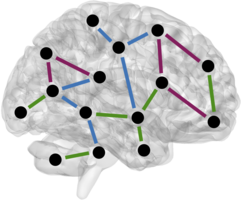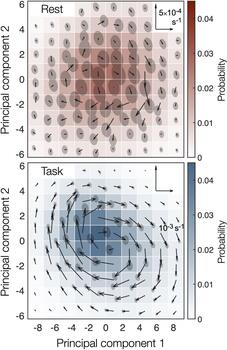The ability to reduce everything to simple fundamental laws does not imply the ability to start from those laws and reconstruct the universe.
P. W. Anderson
Living systems are inherently complex, with microscopic interactions building upon one another to produce macroscopic behaviors and impressive feats of information processing. Experimental advances now allow us to map these interactions, from proteins to cells to entire organisms. Yet fundamental questions remain: How do large-scale patterns of activity emerge from networks of fine-scale interactions? And how do these patterns evolve in time to communicate and process information? Answering these questions requires new theoretical insights to distill the recent explosion of high-quality data down to basic underlying principles.
In our research, we aim to address this gap between theory and data. We leverage techniques from statistical physics, information theory, and network science to study how collective patterns emerge and dynamically evolve in living systems; and to understand how these patterns encode, communicate, and compress information. While we often apply these ideas to explore the brain (across cellular, systems, and cognitive levels), the analytic and computational techniques we develop are equally relevant for other complex living systems. As a result, we are interested in understanding emergence and information processing broadly across organisms, scales, and experimental modalities.
Physics of brain network structure and function

- Christopher W. Lynn and Dani S. Bassett. The physics of brain network structure, function, and control. Nature Reviews Physics (2019). | Nat Rev Phys
- Christopher W. Lynn, Caroline M. Holmes, and Stephanie E. Palmer. Heavy-tailed neuronal connectivity arises from Hebbian self-organization. | bioRxiv
-
Christopher W. Lynn, Qiwei Yu, Rich Pang, William Bialek, and Stephanie E. Palmer. Exactly solvable statistical physics models for large neuronal populations. | arXiv
- Christopher W. Lynn, Caroline M. Holmes, and Stephanie E. Palmer. Emergent scale-free networks. | arXiv
Irreversibility and the arrow of time

-
Christopher W. Lynn, Eli J. Cornblath, Lia Papadopoulos, Maxwell A. Bertolero, and Dani S. Bassett. Broken detailed balance and entropy production in the human brain. Proceedings of the National Academy of Sciences (2021). | PNAS
- Christopher W. Lynn, Caroline M. Holmes, William Bialek, and David J. Schwab. Decomposing the local arrow of time in interacting systems. Physical Review Letters (2022). | PRL
- Christopher W. Lynn, Caroline M. Holmes, William Bialek, and David J. Schwab. Emergence of local irreversibility in complex interacting systems. Physical Review E (2022). | PRE
Human network learning and information processing

-
Christopher W. Lynn and Dani S. Bassett. How humans learn and represent networks. Proceedings of the National Academy of Sciences (2020). | PNAS
- Christopher W. Lynn, Lia Papadopoulos, Ari E. Kahn, and Dani S. Bassett. Human information processing in complex networks. Nature Physics (2020). | Nat Phys
- Christopher W. Lynn, Ari E. Kahn, Nathaniel Nyema, and Dani S. Bassett. Abstract representations of events arise from mental errors in learning and memory. Nature Communications (2020). | Nat Commun
- Christopher W. Lynn and Dani S. Bassett. Quantifying the compressibility of complex networks. Proceedings of the National Academy of Sciences (2021). | PNAS
Inference and control of social networks

-
Christopher W. Lynn, Lia Papadopoulos, Daniel D. Lee, and Dani S. Bassett. Surges of collective human activity emerge from simple pairwise correlations. Physical Review X (2019). | Phys Rev X
-
Christopher W. Lynn and Daniel D. Lee. Statistical Mechanics of Influence Maximization with Thermal Noise. Europhysics Letters (2017). | EPL
-
Christopher W. Lynn and Daniel D. Lee. Maximizing Influence in an Ising Network: A Mean-Field Optimal Solution. In Advances in Neural Information Processing Systems (2016). | NeurIPS